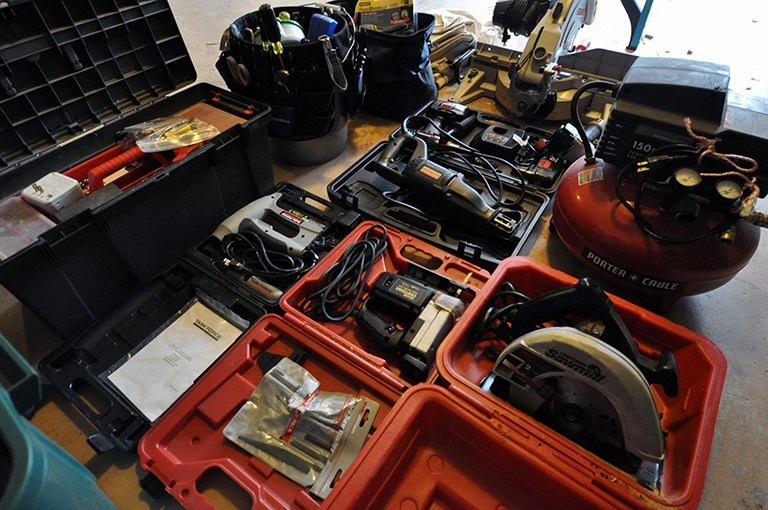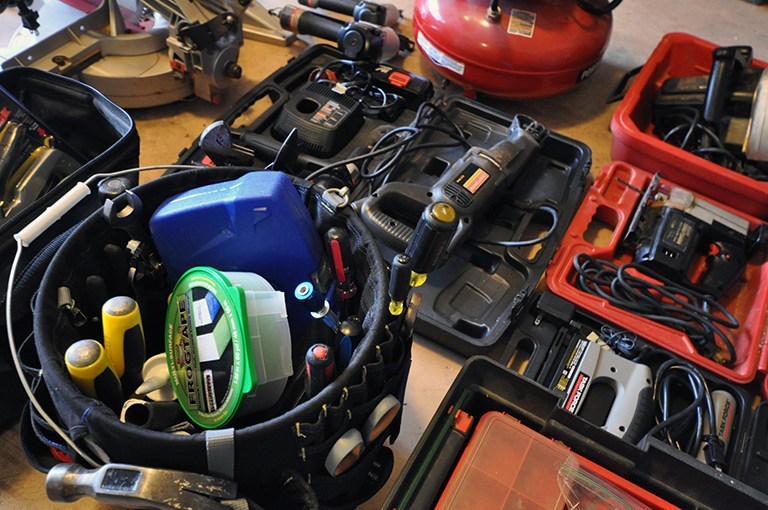If I have one regret during my college education is that I never worked on a construction site. Once I graduated from college, I went straight to work in an architectural office, drawing up all sorts of stuff that I had literally never seen before in my life. I managed to get along but I was acutely aware of my lack of practical knowledge and I have been trying to make up for it over the last 20+ years.
We’d like to thank today’s guest, Nicholas Renard, the owner, architect and registered residential contractor of Dig-Architecture, an architect-led design-build firm in Jacksonville, Florida. We recorded today’s episode live in Las Vegas from the Expo floor of the 2019 AIA Conference on Architecture as special guests of Huber Engineered Woods.
 A small portion of Bob’s tool collection
A small portion of Bob’s tool collection
My practical experience, and I suppose formal construction education, really didn’t start until I bought my first house and didn’t have the money to pay someone else to do the work. My wife had a job that required an extensive amount of traveling and since I am not a “go out to the bar” kind of dude (despite what others might think) I would stay home in the evenings and work on projects around the house. It was during this time that I started building up my tool collection.
Did either of you work construction when you were in architecture school? [2:30 mark]
Both Bob and Nick worked on projects with their father around the house and this gave them their initial exposure to the basics of the construction process. They spent time either watching or helping their fathers around the house as they took on projects of various scales. But of the three, Andrew is the only one who has ever actually worked in the construction industry during their architectural education. Andrew worked in construction during the summers as a high school student. Then, while in grad school, he worked in a cabinetry shop construction custom cabinetry in a small shop in Oregon. Apparently, the common thread among the three of us is having built a deck in our backyards at some point in our lives.
How do you think working in construction would benefit an architect? [10:17 mark]
The translation from the drawing environment to the built environment typically takes time for a new professional in architecture. The knowledge of the process of construction, the tolerances involved, the order of operations and other physical activities all have an impact on the design and final product. So being able to understand all of these aspects of the downstream portions of your design is very beneficial and can impact your ability as a designer to impact the final result, the budget, and the overall process. Being able to understand and apply this to your projects is a valuable skill for any architect.
Understanding the differences between the exactness of the drawing environment versus the built environment. [14:30 mark]
The system of education tends to push you as an architecture student to strive for perfection in your processes. This seems to translate over into your career and the way you design or draw digitally. The reality of the construction site is that there is not a possibility for perfection. Part of being on a construction site allows you to understand the tolerances of this process. Every part of the assemblies on a job site has built-in tolerances. And as they are assembled, those tolerances compound and create project dimensions that cannot be held to the digital perfection. Understanding this concept and how it affects your design is something that takes time as a young professional. One of the benefits of being on construction sites early in your education or career is that it reduces this time frame and allows you to grasp that concept quicker, move forward and apply it to your work.
Did you ever want to be a contractor? [25:15 mark]
Both Nick and Andrew had thoughts of being a contractor in their youth, however short-lived. Bob did not have those aspirations as a young person, but as he spent more and more time on construction sites as an architect, he wonders about “missing his calling” because he enjoys it so much. But now, as this point of his career, the best parts of being on a job site is learning about the processes and creating a relationship with the team that is constructing your design idea. But the idea is that we all want to make the construction process a collaborative one between architect and constructors.
 A small portion of Bob’s tool collection
A small portion of Bob’s tool collection
How much time do you spend on the job site? [31:28 mark]
Nick manages to make it to his job sites daily. He is able to accomplish this due to their proximity to each other and his office. He can get to all his current job sites in roughly 20 minutes so he spends plenty of time on his projects. Andrew does not get that opportunity due to the locations of his projects. He typically makes it to job sites about every two weeks depending on job site activity. But he also is available to be on-site within 24 hours if requested by the clients. Bob spends as much time on his job sites as allowable – he does this in his spare time even he loves it so much.
For all three the main factor of site visitation is about proximity; if they are closer, then we are much more likely to spend time on the job site. We enjoy being on-site and believe the positive impact we can have on our projects during this process is a benefit to everyone involved. There are some professionals that attempt to limit their liability by staying away from job sites and being able to claim a lack of knowledge. But for us, the objective is to be on-site more often to reduce the number of possible conflicts and issue with the design and construction coordination. We all want the project to be completed as close to our design intent as possible. So the enjoyment of visiting our project job sites (or any job site in general) is something that we three share in common.
What do architects like to steal from job sites? [40:20 mark]
It seems we all have a proclivity to takes small things from the job sites we visit. Andrew asks contractors for permission these days to take waste materials from job sites for his at-home projects. As a kid, Bob’s ideal vacation would have been a trip to a subdivision development to be able to peruse as many houses under construction as possible (sticks of nails glued together for use in nail guns were highly prized “acquisitions!). Nick claims to not take things from job sites … he picks up some things if they are “left” behind. During this bit of the conversation, we get a nice glimpse of a little Bob who loved to visit construction sites, find discarded treasures and possibly had an unhealthy love of magnets!

Hypothetical [44:15 mark]
Continuing the trend of presenting our guests with a hypothetical question, Nick gets a chance to join in the fun and he was admittedly nervous.
"If you could learn any one skill in the world in an instant, like press a button and BAM! You can do this, what skill would that be?"
Of course, Andrew always thinks that I disagree with his answers, and there is some merit to his thinking, but for today’s hypothetical question, Andrew and I definitely agree that Nick has taken over the top spot for the worst hypothetical answer ever.
I can’t help but think how working on my own houses over the years has fundamentally shaped how I think as an architect when I walk onto a job site. As a result of all the time I spent trying to get things right when I’m the one swinging the hammer, I have a deeper appreciation for the craftsmanship I am hopefully observing and a better understanding of the effort it takes to create the desired result.
If you are a young architect or plan on becoming an architect one day, I think the best advice I can give you is to find your way onto a construction site – even if that construction site is your own.
Cheers,

We would like to thank Huber Engineered Woods for their support of today’s episode. Huber Engineered Woods has a variety of approved CEU courses to educate Architects on tighter building envelopes, mitigating moisture intrusion, resiliency and more. Let one of our sales representatives come to your office and give a lunch and learn. They will provide lunch and educate you not only on their products but best building practices as well.
To find your local Sales Representative, please visit www.huberwood.com/contact-us.






